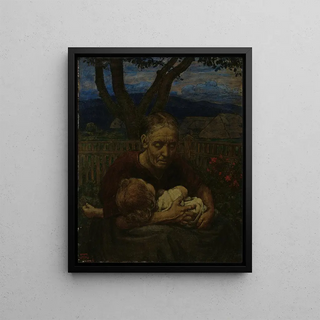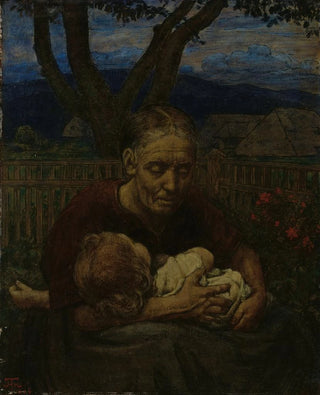Art print | Mother and Child in a Garden - Hans Thoma


View from behind

Frame (optional)
In the fascinating world of art, some works stand out for their ability to transcend time and capture moments of striking beauty. "Mother and Child in a Garden" by Hans Thoma is one of those creations that evoke timeless tenderness. This painting, a true ode to motherhood and nature, immerses the viewer in an idyllic scene where the simplicity of everyday life blends with the depth of human emotions. Through this work, Thoma invites us to explore the subtleties of the relationship between a mother and her child, while immersing us in a lush garden, a symbol of life and serenity.
Style and uniqueness of the work
Hans Thoma's style is often characterized by a harmonious fusion of realism and symbolism. In "Mother and Child in a Garden," this duality is expressed with rare delicacy. Vibrant colors and gentle forms create a warm atmosphere, where each element seems alive. The mother, depicted with palpable tenderness, is surrounded by lush vegetation that not only embellishes the scene but also reinforces the idea of a natural refuge. The meticulous details, from flower petals to the expressions of the characters, testify to the artist's attention to the beauty of simple things. This work is not just a painting; it becomes an open window to a world where maternal love and nature intertwine in a harmonious dance.
The artist and his influence
Hans Thoma, born in 1839 in Germany, is an emblematic figure of the 19th-century artistic movement. Influenced by Romanticism and the Symbolist movement, Thoma developed a style that is uniquely his own, blending tradition and innovation. His work is marked by a deep connection with nature, which he considers an inexhaustible source of inspiration. By incorporating folk themes and motifs of rural life into his creations, he captured the essence of the German soul. "Mother and Child in a Garden" perfectly illustrates this approach, where the simplicity of the scene evokes universal feelings. Thoma's impact on his contemporaries and future generations

Matte finish

View from behind

Frame (optional)
In the fascinating world of art, some works stand out for their ability to transcend time and capture moments of striking beauty. "Mother and Child in a Garden" by Hans Thoma is one of those creations that evoke timeless tenderness. This painting, a true ode to motherhood and nature, immerses the viewer in an idyllic scene where the simplicity of everyday life blends with the depth of human emotions. Through this work, Thoma invites us to explore the subtleties of the relationship between a mother and her child, while immersing us in a lush garden, a symbol of life and serenity.
Style and uniqueness of the work
Hans Thoma's style is often characterized by a harmonious fusion of realism and symbolism. In "Mother and Child in a Garden," this duality is expressed with rare delicacy. Vibrant colors and gentle forms create a warm atmosphere, where each element seems alive. The mother, depicted with palpable tenderness, is surrounded by lush vegetation that not only embellishes the scene but also reinforces the idea of a natural refuge. The meticulous details, from flower petals to the expressions of the characters, testify to the artist's attention to the beauty of simple things. This work is not just a painting; it becomes an open window to a world where maternal love and nature intertwine in a harmonious dance.
The artist and his influence
Hans Thoma, born in 1839 in Germany, is an emblematic figure of the 19th-century artistic movement. Influenced by Romanticism and the Symbolist movement, Thoma developed a style that is uniquely his own, blending tradition and innovation. His work is marked by a deep connection with nature, which he considers an inexhaustible source of inspiration. By incorporating folk themes and motifs of rural life into his creations, he captured the essence of the German soul. "Mother and Child in a Garden" perfectly illustrates this approach, where the simplicity of the scene evokes universal feelings. Thoma's impact on his contemporaries and future generations






